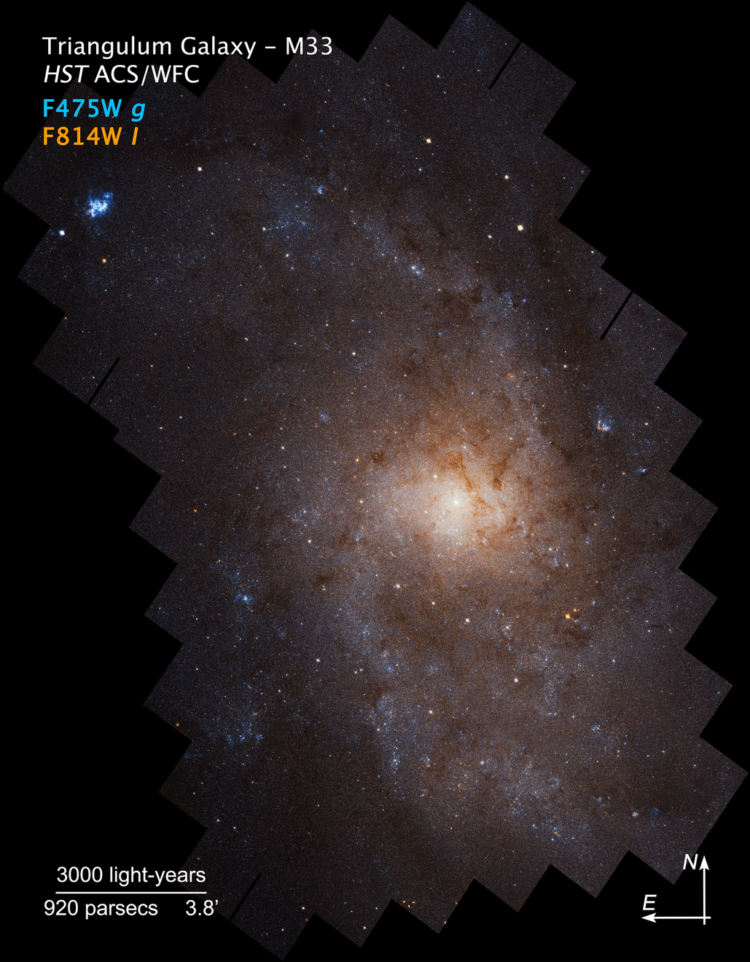On January 11th, 2023 at the 241st meeting of the American Astronomical Society in Seattle, a research group headed by researchers at the University of Washington and the Center for Computational Astrophysics revealed new research with the help of the Panchromatic Hubble Andromeda Treasury Triangulum Extended Region—or PHATTER—survey.

A composite image of the Triangulum galaxy, made by overlaying individual images taken by the Hubble Space Telescope as part of the PHATTER survey. Image Credit: A. Smercina/M.J. Durbin/J. Dalcanton/B.F. Williams/University of Washington/NASA/ESA.
The attempt is offering astrophysicists their first detailed look at the diverse populations of stars that fabricate the Triangulum galaxy.
Scientists discovered the fact that this satellite galaxy, a close companion of the much bigger Andromeda galaxy, has two considerably different structures based on the age of the stars.
The youngest stars and the oldest stars in the Triangulum galaxy—which we can separate out using multiple wavelength filters on the Hubble Space Telescope—are organized very differently.
Adam Smercina, Postdoctoral Researcher, University of Washington
Smercina added, “This is surprising. For a lot of galaxies, like the Milky Way and Andromeda, the stars are distributed roughly consistently, regardless of their age. That is not the case with Triangulum.”
At around 61,000 light-years across, Triangulum is known as the third-largest galaxy present in the local group, following Andromeda and the Milky Way. In lower-resolution images, it consists of a “flocculent” structure—with several small spiral arms beaming out from a well-specified center.
For the PHATTER survey, the Hubble Space Telescope took hundreds of high-resolution images of several sections of the Triangulum galaxy in 108 orbits during the course of over a year.
The research group helped put together smaller-section images collectively to make an extensive, high-resolution dataset available for Triangulum that initially displayed the individual stars of the Galaxy over a large region in its center.
As a result of Hubble’s array of filters, scientists were also capable of isolating stars by age. The distribution of younger and bigger stars, those that were less than 1 billion years in age, was approximately in accordance with the “flocculent” pattern which the Triangulum is well known for.
It's older and redder stars are scattered in a very unique pattern: two spiral arms radiating out from a rectangular bar at the center of the Galaxy.
This was a largely unknown and hidden feature of the Triangulum galaxy that was very difficult to see without this kind of detailed survey.
Adam Smercina, Postdoctoral Researcher, University of Washington
According to Smercina, old stars make up most of Triangulum’s mass but seem to be dimmer compared to their younger counterparts. That could describe the fact why the “flocculent” pattern exists in the Galaxy’s low-resolution images.
Furthermore, the survey team is not aware of the fact that why young and old stars have such diverse distributions in the Triangulum. Normally, satellite galaxies are known as an eclectic bunch, and several questions remain regarding their development and evolution.
Satellite galaxies take various shapes and can be molded through interactions with their parent galaxies. The biggest satellite galaxy of the Milky Way called the Large Magellanic Cloud, for instance, is alike to Triangulum’s size and mass. However, it has a globular and irregular shape as a result of its vicinity to the Galaxy.
The continuous analysis of the PHATTER survey provides new insights into how such kinds of galaxies tend to develop and interact with their bigger neighbors. The research group plans to track such initial outcomes by tracing the history of star formation in Triangulum, thereby making a comparison of the Galaxy’s different sections.
A major goal of the PHATTER survey was to generate the kind of detailed, high-resolution data on this prominent satellite galaxy that will allow us to examine its structure in depth, trace its history of star formation and compare what we see to theories of galaxy formation and evolution. We’re already finding surprises.
Adam Smercina, Postdoctoral Researcher, University of Washington
The other members of the team include Julianne Dalcanton, director of the Center for Computational Astrophysics in New York, a UW professor of astronomy and principal investigator of the PHATTER project; UW research associate professor of astronomy Benjamin Williams; UW doctoral student Meredith Durbin; and Margaret Lazzarini, a postdoctoral researcher at Caltech.